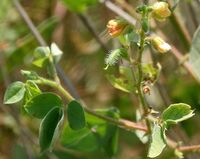Biology:Caesalpinioideae
| Caesalpinioideae | |
|---|---|

| |
| Royal poinciana, Delonix regia | |
| Scientific classification | |
| Kingdom: | Plantae |
| Clade: | Tracheophytes |
| Clade: | Angiosperms |
| Clade: | Eudicots |
| Clade: | Rosids |
| Order: | Fabales |
| Family: | Fabaceae |
| Subfamily: | Caesalpinioideae DC. 1825 |
| Type genus | |
| Caesalpinia L.
| |
| Clades | |
|
See text | |
| Synonyms | |
Caesalpinioideae is a botanical name at the rank of subfamily, placed in the large family Fabaceae or Leguminosae. Its name is formed from the generic name Caesalpinia. It is known also as the peacock flower subfamily.[5] The Caesalpinioideae are mainly trees distributed in the moist tropics, but include such temperate species as the honeylocust (Gleditsia triacanthos) and Kentucky coffeetree (Gymnocladus dioicus). It has the following clade-based definition:
The most inclusive crown clade containing Arcoa gonavensis Urb. and Mimosa pudica L., but not Bobgunnia fistuloides (Harms) J. H. Kirkbr. & Wiersema, Duparquetia orchidacea Baill., or Poeppigia procera C.Presl[6]
In some classifications, for example the Cronquist system, the group is recognized at the rank of family, Caesalpiniaceae.
Characteristics
- Specialised extrafloral nectaries often present on the petiole and / or on the primary and secondary rachises, usually between pinnae or leaflet pairs
- Leaves commonly bipinnate
- Inflorescences globose, spicate
- Aestivation valvate
- Anthers often with a stipitate or sessile apical gland
- Pollen commonly in tetrads, bitetrads or polyads
- Seeds usually with an open or closed pleurogram on both faces
- Root nodules variably present and indeterminate
- 10 Stamens, aside from various core mimosoid genera bearing a few factors more
Taxonomy
- Caesalpinieae Clade
- Cassieae Clade
- Batesia Spruce
- Cassia L.
- Chamaecrista Moench
- Melanoxylum Schott
- Recordoxylon Ducke
- Senna Mill.
- Vouacapoua Aubl.
- Dimorphandra Group A
- Burkea Benth.
- Campsiandra Benth.
- Dimorphandra Schott pro parte
- Dinizia Ducke
- Mora Benth.
- Stachyothyrsus Harms
- Dimorphandra Group B
- Dimorphandra Schott pro parte
- Diptychandra Tul.
- Erythrophleum Afzel. ex R.Br.
- Moldenhawera Schrad.
- Pachyelasma Harms
- Sympetalandra Stapf
- Mimosoid clade (~40 genera)
- Peltophorum Clade
- Bussea Harms
- Colvillea Bojer ex Hook.
- Conzattia Rose
- Delonix Raf.
- Heteroflorum M. Sousa
- Lemuropisum H.Perrier
- Parkinsonia L.
- Peltophorum (Vogel) Benth.
- Schizolobium Vogel
- Tachigali Clade
- Arapatiella Rizzini & A.Mattos
- Jacqueshuberia Ducke
- Tachigali Aubl. (including Sclerolobium)
- Umtiza Clade
- Acrocarpus Wight & Arn.
- Arcoa Urb.
- Ceratonia L.
- Gleditsia L.
- Gymnocladus Lam.
- Tetrapterocarpon Humbert
- Umtiza Sim
- Unassigned
- Pterogyne Tul.
Phylogenetics
Caesalpinioideae, as it was traditionally circumscribed, was paraphyletic. Several molecular phylogenies in the early 2000s showed that the other two subfamilies of Fabaceae (Faboideae and Mimosoideae) were both nested within Caesalpinioideae.[7][8][9][10] Consequently, the subfamilies of Fabaceae were reorganized to make them monophyletic.[6] Caesalpinioideae, as currently defined, contains the following subclades:[8]
| Fabales |
| ||||||||||||||||||||||||||||||||||||||||||||||||
References
- ↑ "Fabales". https://mobot.org/MOBOT/research/APweb/orders/fabalesweb.htm.
- ↑ "Locating evolutionary precursors on a phylogenetic tree". Evolution 66 (12): 3918–3930. 2012. doi:10.1111/j.1558-5646.2012.01720.x. PMID 23206146.
- ↑ Doyle JJ (2011). "Phylogenetic perspectives on the origins of nodulation". Molecular Plant-Microbe Interactions 24 (11): 1289–1295. doi:10.1094/MPMI-05-11-0114. PMID 21995796.
- ↑ Doyle JJ (2012). "Polyploidy in legumes". Polyploidy and genome evolution. Berlin, Heidelberg: Springer. pp. 147–180. doi:10.1007/978-3-642-31442-1_9. ISBN 978-3-642-31441-4.
- ↑ "Flowers in Singapore". http://flowersinsingapore.blogspot.sg/search/label/Peacock%20flower%20%EF%BC%88%E5%AD%94%E9%9B%80%E8%8A%B1%EF%BC%89.
- ↑ 6.0 6.1 The Legume Phylogeny Working Group (LPWG). (2017). "A new subfamily classification of the Leguminosae based on a taxonomically comprehensive phylogeny". Taxon 66 (1): 44–77. doi:10.12705/661.3.
- ↑ "Phylogenetic Relationships in the Caesalpinioideae (Leguminosae) as Inferred from Chloroplast trnL Intron Sequences". Syst Bot 26 (3): 487–514. 2001. doi:10.1043/0363-6445-26.3.487. http://www.bioone.org/doi/full/10.1043/0363-6445-26.3.487.
- ↑ 8.0 8.1 "Phylogenetic patterns and diversification in the caesalpinioid legumes". Botany 86 (7): 697–718. 2008. doi:10.1139/B08-058.
- ↑ "Phylogeny reconstruction in the Caesalpinieae grade (Leguminosae) based on duplicated copies of the sucrose synthase gene and plastid markers". Molecular Phylogenetics and Evolution 65 (1): 149–162. 2012. doi:10.1016/j.ympev.2012.05.035. PMID 22699157.
- ↑ "Reconstructing the deep-branching relationships of the papilionoid legumes". S. Afr. J. Bot. 89: 58–75. 2013. doi:10.1016/j.sajb.2013.05.001.
Wikidata ☰ Q157156 entry
 |


